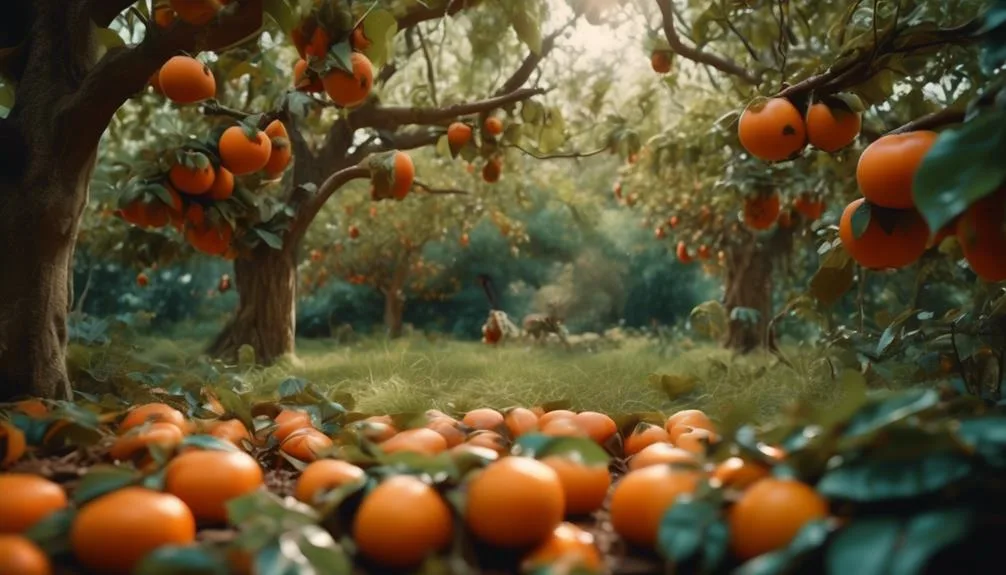Persimmon trees are a popular food source for wildlife, attracting 50+ bird species and many mammals. If you're looking to improve your property for wildlife, consider the important role persimmon trees play in creating a diverse habitat.
But it's not just about planting trees – there's a science and art to designing a wildlife habitat with persimmons. Let's explore how you can use persimmon trees to build a thriving ecosystem for wildlife.
Key Takeaways
- Persimmon trees are beneficial for wildlife as they attract a wide variety of bird species and mammals.
- Selecting the right persimmon tree species is crucial for the success of the habitat, considering adaptability, fruit production, and attractiveness to wildlife.
- Designing the habitat with persimmon trees should involve careful consideration of layout and placement, clustering trees for concentrated food sources, and incorporating other native plants.
- Regular maintenance and care, including monitoring for damage, maintaining native plants and water sources, and removing invasive species, are essential for supporting local wildlife.
Benefits of Persimmon Trees for Wildlife
Persimmon trees provide a valuable food source and shelter for a variety of wildlife, making them an essential component of a thriving ecosystem. These trees are a wildlife attraction, drawing in various species due to their abundant fruit and dense foliage.
The ecological balance is maintained as persimmon trees support biodiversity by providing a natural food source for animals such as deer, raccoons, and birds. The fruits are rich in nutrients and are eagerly consumed by many creatures, helping to sustain their populations.
Additionally, the dense canopy and sturdy branches of persimmon trees offer crucial shelter and nesting sites for birds and small mammals, further enhancing their value in supporting wildlife.
With their ability to attract and sustain diverse animal life, persimmon trees play a vital role in creating and maintaining a flourishing habitat.
Selecting the Right Persimmon Tree Species
Wondering which persimmon tree species is best suited for creating a wildlife habitat in your area? When selecting the right persimmon tree species, consider the following:
- Tree selection: Choose native persimmon species like American persimmon (Diospyros virginiana) for better adaptability and resilience.
- Fruit production: Opt for varieties with abundant fruit production, such as the 'Yates' or 'Meader' cultivars, to provide a food source for wildlife throughout the year.
- Wildlife attraction: Look for species known to attract a diverse range of wildlife, such as the 'Prok' or 'Early Golden' persimmon trees, which are highly appealing to deer, birds, and other animals.
- Habitat suitability: Select persimmon trees that are well-suited to your specific climate and soil conditions to ensure successful establishment and long-term habitat value.
Choosing the right persimmon tree species can significantly impact the success of your wildlife habitat project.
Designing the Habitat With Persimmon Trees
When creating a wildlife habitat with persimmon trees, it's essential to carefully consider the layout and placement of the trees to maximize their impact on the local ecosystem.
Persimmon trees not only provide food for wildlife but also serve as a valuable addition to your landscaping.
Designing the habitat with persimmon trees involves creating a layout that encourages wildlife attraction while also considering the environmental impact.
Clustering persimmon trees in groups can create a more significant impact on wildlife, as it provides a concentrated food source and shelter.
Additionally, incorporating other native plants within the habitat can further enhance its appeal to various wildlife species.
When strategically placed, persimmon trees can significantly contribute to habitat creation, supporting the local ecosystem, and promoting biodiversity.
Properly designed persimmon habitats can positively impact the environment, making them a valuable addition to any wildlife conservation effort.
Maintenance and Care for a Wildlife Habitat
To maintain and care for a wildlife habitat, you must regularly assess the condition of the habitat and make any necessary adjustments to ensure its continued support for local wildlife. Here are four essential maintenance tasks to help you in maintaining the ecosystem and attracting wildlife:
- Regular Inspections: Walk through the habitat regularly to check for any signs of damage or disturbances.
- Native Plant Care: Ensure that native plants are healthy and thriving to provide food and shelter for wildlife.
- Water Sources: Monitor and maintain water sources to ensure they're clean and accessible for wildlife.
- Control Invasive Species: Regularly remove invasive plant species that can disrupt the balance of the ecosystem.
Encouraging Wildlife to Thrive With Persimmon Trees
Encourage local wildlife to thrive by incorporating persimmon trees into your wildlife habitat. These trees provide nourishment and shelter for a variety of species. Persimmon trees are exceptional for attracting birds. Their sweet, flavorful fruit serves as a vital food source for numerous bird species. When birds are drawn to your persimmon trees, they contribute to supporting biodiversity by aiding in seed dispersal and insect control within the habitat. The presence of birds also adds to the overall vibrancy of the ecosystem, creating a delightful and dynamic environment.
Additionally, the dense foliage of persimmon trees offers nesting sites and protection for birds. This further enhances their attractiveness to a diverse array of avian species. By fostering a hospitable environment with persimmon trees, you play a crucial role in promoting the flourishing of local wildlife.
Conclusion
Incorporating persimmon trees into your landscape not only provides delicious fruit and dense foliage but also creates a thriving wildlife habitat. By carefully selecting the right species, thoughtful design, and proper care, you can invite a diverse range of wildlife to flourish in your own backyard.
Consider the impact of planting persimmon trees and the lasting benefits for the natural world around you.

